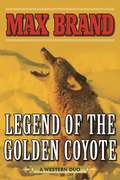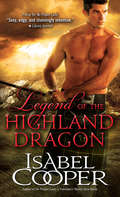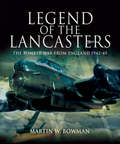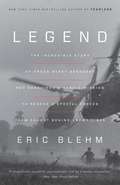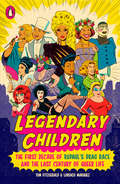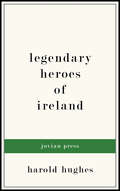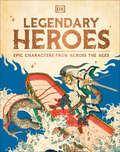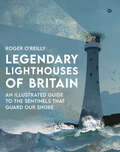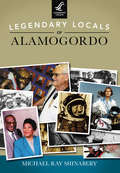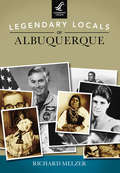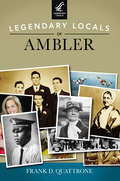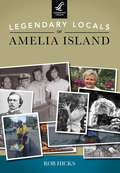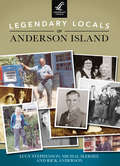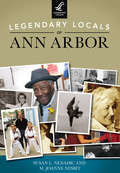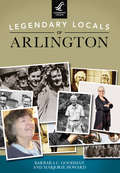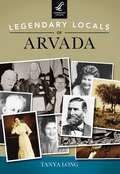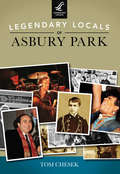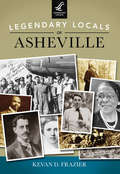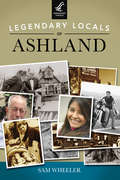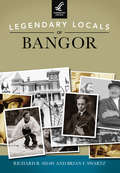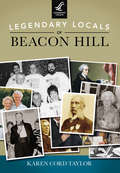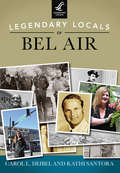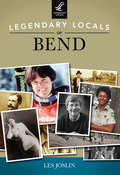- Table View
- List View
Legend of the Golden Coyote: A Western Duo
by Max Brand“Thunder and Lightning” is the story of two men, Soapy Almayer and Jimmy Clarges. When they go to work in a lumber camp, their extraordinary strength and the speed that they work leads to their being called Thunder and Lightning. Then one man, afraid to fight either, is crafty enough to use Rosita Alvarado to cause them to fight each other … to the death.“Legend of the Golden Coyote” is the story of a wild coyote, known far and wide for his unusual golden coat. Crafty and ferocious, he will confront even a timber wolf. But he also has a special relationship with a man and his daughter: the girl loves him and the man has spared his life when he might have killed him. When a terrible forest fire threatens them all, the golden coyote faces the painful choice between saving one of his own offspring and leading the human to safety.
Legend of the Highland Dragon
by Isabel CooperHe Guards a Ferocious Secret In Victorian England, gossip is often as precious as gold. But the Highlanders are a more mysterious bunch. And if anyone found out that Stephen MacAlasdair really was, he'd be hunted down, murdered, his clan wiped out. As he's called to London on business, he'll have to be extra vigilant--especially between sunset and the appearance of the first evening star. Mina just wanted to find out more about the arrogant man who showed up in her employer's office. Some might say it was part of her job. She never thought the stranger would turn into a dragon right in front of her. Or that he'd then offer her an outrageous sum of money to serve as his personal secretary. Working together night and day to track a dangerous enemy, Mina comes to see a man in love is more powerful and determined than any dragon. "A genre-bending, fast-paced whirl with fantastic characters, a deftly drawn plot, and sizzling attraction."--RT Book Reviews on No Proper Lady, a Reviewers' Choice Award Winner
Legend of the Lancasters: The Bomber War from England, 1942–45
by Martin W. BowmanThis book is a riveting account told in ten big chapters of the young RAF crews who flew Lancasters in RAF Bomber Command from 1942 to the end of the war in Europe in April 1945. It is unique in that the story is told using first person accounts from RAF aircrew and German night fighter crews who fought each other on raids on occupied Europe and Germany from 1942 onwards. Details of what it was like to be on the receiving end in Hamburg, Berlin, Cologne etc are also included. A whole host of incredible first-hand accounts by British, Commonwealth, American and German air crews permeate the action and describe the aerial battles as only they can. This unique book also includes many accounts and photos that have not previously been seen before while the rich mix of combat accounts from all sides are brought together for the first time in one volume.
Legend: The Genesis Of Civilisation (A Test of Time #2)
by David RohlDavid Rohl continues his quest to reach the historical kernel lying at the heart of some of the greatest unsolved problems and mysteries of Old World history and archaeology. He reveals what really happened in seven famous myths and legends bequeathed to us by the ancients and shows us that the passage of time has not wiped away all the evidence, and it is possible to reach the reality behind the legends.
Legend: The Incredible Story of Green Beret Sergeant Roy Benavidez's Heroic Mission to Rescue a Special Forces Team Caught Behind Enemy Lines
by Eric BlehmThe true story of the U.S. Army&’s 240th Assault Helicopter Company and a Green Beret Staff Sergeant's heroic mission to rescue a Special Forces team trapped behind enemy lines during the Vietnam War, from New York Times bestselling author Eric Blehm. On May 2, 1968, a twelve-man Special Forces team covertly infiltrated a small clearing in the jungles of neutral Cambodia—where U.S. forces were forbidden to operate. Their objective, just miles over the Vietnam border, was to collect evidence that proved the North Vietnamese Army was using the Cambodian sanctuary as a major conduit for supplying troops and materiel to the south via the Ho Chi Minh Trail. What the team didn&’t know was that they had infiltrated a section of jungle that concealed a major enemy base. Soon they found themselves surrounded by hundreds of NVA, under attack, low on ammunition, stacking the bodies of the dead as cover in a desperate attempt to survive the onslaught. When Special Forces Staff Sergeant Roy Benavidez heard their distress call, he jumped aboard the next helicopter bound for the combat zone. What followed would become legend in the Special Operations community. Flown into the foray of battle by the 240th Assault Helicopter Company, Benavidez jumped from the hovering aircraft, ran nearly 100 yards through withering enemy fire, and--despite being immediately and severely wounded--organized an extraordinary defense and rescue of the Special Forces team. Written with extensive access to family members, surviving members of the 240th Assault Helicopter Company, on-the-ground eye-witness accounts never before published, as well as recently discovered archival, and declassified military records, Blehm has created a riveting narrative both of Roy Benavidez&’s life and career, and of the inspiring, almost unbelievable events that defined the brotherhood of the air and ground warriors in an unpopular war halfway around the world. Legend recounts the courage and commitment of those who fought in Vietnam in service of their country, and the story of one of the many unsung heroes of the war.
Legendary Children: The First Decade of RuPaul's Drag Race and the Last Century of Queer Life
by Tom Fitzgerald Lorenzo MarquezA definitive deep-dive into queer history and culture with hit reality show RuPaul's Drag Race as a touchstone, by the creators of the pop culture blog Tom and LorenzoFrom the singular voices behind Tom and Lorenzo comes the ultimate guide to all-things RuPaul's Drag Race and its influence on modern LGBTQ culture. Legendary Children centers itself around the idea that not only is RuPaul's Drag Race the queerest show in the history of television, but that RuPaul and company devised a show that serves as an actual museum of queer cultural and social history, drawing on queer traditions and the work of legendary figures going back nearly a century. In doing so, Drag Race became not only a repository of queer history and culture, but also an examination and illustration of queer life in the modern age. It is a snapshot of how LGBTQ folks live, struggle, work, and reach out to one another--and how they always have--and every bit of it is tied directly to Drag Race. Each chapter is an examination of a specific aspect of the show--the Werk Room, the Library, the Pit Crew, the runway, the Untucked lounge, the Snatch Game--that ties to a specific aspect of queer cultural history and/or the work of certain legendary figures in queer cultural history.
Legendary Heroes of Ireland
by Harold HughesThese stories are offered in the hope that they may help promote the love of reading in our boys and girls. After all, our duty in teaching reading is not in the subject matter but in the desire. If we show to the child that the art of reading is the golden key which will unlock the storehouse of life enjoyment, and give him the love for the secrets of the printed page, we may consider that our educational effort has been well spent. So the primary object in writing these stories has not been to chronicle history but to give the child something interesting and entertaining.
Legendary Heroes: Epic Characters from Across the Ages
by DKMeet the bold, the brave, and the brilliant – over 100 individual heroes of legend from cultures around the world are profiled in an engaging and fun way!Explore the adventures of more than 100 heroes of ancient legend, brought to life in this striking book for children aged 9-12.Featuring bright and colorful photography, authentic artworks, and terrific tales from cultures around the world, Legendary Heroes is the ultimate page-turner for budding heroes everywhere. This book celebrates timeless heroism, incredible bravery, supreme strength, keen intelligence, and exceptional self-sacrifice.This magical book on legends for kids offers: Rare contemporary and authentic images bring the world’s myths, legends, and folklore to life.More than 100 creatures featured throughout in incredible detail.Culturally authentic and historically accurate imagery showing each creature alongside compelling text breaking down each one.Join Beowulf as he comes face-to-face with a fire-breathing dragon, sail with Sindbad as he grapples with gargantuan giants and sinister snakes, watch Maui lift the sky, and ride into battle with warrior princess Yennenga. This guide brings to life a truly eclectic mix of more than 100 heroes. Some are natural-born champions, others find courage in the face of supernatural monsters or vengeful rivals, and still more go on epic quests and arduous voyages to find wisdom and enlightenment. But they all come together as the stars of the most magnificent and memorable tales ever told.More in the seriesIf you enjoyed learning about ancient legends in Legendary Heroes, then why not try the other book in the series Supernatural Creatures to learn about spooky myths and folklore?
Legendary Lighthouses of Britain: Ghosts, Shipwrecks & Feats of Heroism
by Roger O'ReillyPacked with legends, sea lore and exciting true-life tales, this is a highly giftable treasure trove of Britain's top 100 lighthouses, each one illustrated by award-winning artist Roger O'Reilly.This is a unique celebration of 100 of the most dramatic and storied lighthouses along the coasts of Britain. Illustrated with fantastic retro art by award-winning artist Roger O'Reilly, this guide to the sentinels that guard Britain's shores is aimed at walkers, art lovers, maritime and countryside enthusiasts, and anyone who just loves lighthouses!.From the Lizard in Cornwall to Muckle Flugga at the northern tip of the Shetlands, and out to the forbidding rock stations that lie offshore in the path of ferocious and unforgiving seas, Roger O'Reilly has selected the very best of Britain's lighthouses with all their sea legends, folklore and tales of ghosts, shipwrecks and endurance. Including:Souter on the Sunderland coast, reputed to be haunted by Grace Darling&’s niece Isabella, who lived here in the late 1880s. Staff have reported spoons floating in mid-air, unexplained temperature drops, and even being clutched by unseen hands.Ardnamurchan in the far west of Scotland, so remote that its builders came down with scurvy, and fresh fruit and vegetables along with a doctor had to be shipped out to help them.Trinity Buoy Wharf – who knew there was a lighthouse in the heart of London? It's now home to the Longplayer, a continuous 1,000-year long piece of music that will run until 31st December 2999.Smalls, off the Pembrokeshire coast, where in 1801 one keeper died and the other went mad, waiting almost four months for rescue while his dead colleague, fastened to the outside rail because the corpse had started to decompose, stared through the window at him accusingly.Lundy South, occupied by Barbary pirates during the 1600s, and in the 18th century the base of Thomas Benson, one time MP for Barnstaple and Devon&’s most notorious smuggler.
Legendary Lionesses: The England Women’s Football Team, 1972–2022
by Jean WilliamsThis is the first academic history of the FA England women’s national football team. Based on unprecedented access to FA data, it details the careers of the 227 women who debuted for England from 1972 to 2022. England won the UEFA Women’s Euros in 2022, and Jean worked with Sarina Wiegman and the squad, on the Legendary Lionesses from 1972.
Legendary Locals of Alamogordo (Legendary Locals)
by Michael Ray ShinaberyBy the time Alamogordo's founders platted the town in the late 1800s, bestowing it with the Spanish name for Fat Cottonwood, the region's lush grasses were luring cowboys such as Oliver Lee. Then, in 1941, an event more than 3,000 miles away changed the quiet community. When the Japanese bombed Pearl Harbor, chamber president Mose Cauthen quickly spearheaded bringing the Army's mission to train bomber pilots to the Tularosa Basin. During the Space Race, Dr. John Stapp oversaw the programs at Holloman Air Force Base that sent Joe Kittinger, Dave Simons, and "Demi" McClure floating heavenward underneath balloons. Soon after, Ed Dittmer was training chimpanzees to rocket out of Earth's atmosphere and prove man could survive in that hostile environment. Alamogordo is where the Old West melds with ever-evolving technology, along with a rich artistic and literary legacy championed by such women as Linnie Townsend, Maude Rathgeber, and Margaret Flickinger.
Legendary Locals of Albuquerque (Legendary Locals)
by Richard MelzerSpanish settlers founded Albuquerque in 1706, making it the third of only four villas (towns) in colonial New Mexico. Located in the Rio Abajo along a wide turn on the Rio Grande, the settlement developed from a small farming community into New Mexico's largest, most modern city. Many notable men and women participated in this remarkable growth, lending their talents and sacrificing their time, energy, and sometimes their very lives. Dozens of these legendary figures are portrayed in this unique book, with chapters devoted to those who played important roles in politics and diplomacy; the military; law and order; religion and education; art and literature; culture and entertainment; business and tourism; health, science, technology, and space; and sports. A final chapter describes several of Albuquerque's sung and unsung heroes. The result is a collage of a Western city filled with diversity, tradition, and cultural pride.
Legendary Locals of Ambler
by Frank D. QuattroneOne of the few towns in America named after a woman, Ambler derives its driving spirit of selflessness and community from the heroine of the Great Train Wreck of 1856. Mary Ambler, a humble Quaker mill owner who came to the aid of dozens of disaster victims, may have been the first of countless Ambler personalities who have devoted themselves to the greater good of the thriving little borough located just outside Philadelphia. Legendary Locals of Ambler celebrates the lives of the sung and unsung heroes--political and civil servants, businessmen and builders, restaurateurs and devotees of the arts, and founders of charitable institutions, such as Henry G. Keasbey and Richard V. Mattison, William E. Strasburg, George E. Saurman, "Bud" Wahl, Mattie Dixon, and Peggy Dolan--whose contributions have made a significant difference in the lives of so many.
Legendary Locals of Amelia Island (Legendary Locals)
by Rob HicksAmelia Island has been host to remarkable people throughout its 500-year history. These people are responsible for giving Amelia the distinction as the only place in the United States to have seen eight different flags. A new railroad followed the Civil War and brought those who sought to take advantage of the burgeoning shipping center. As opportunities waned, the island became a sleepy, blue collar community supported by the local paper mills. Prior to civil rights legislation desegregating the South, Fernandina’s American Beach flourished as an African American coastal community. Meanwhile, local visionaries oversaw tight-knit communities and set the stage for the large resorts that came to the island’s south end in the 1970s. Today, Amelia Island is a national tourist destination and home to a diverse of community of longtime residents and newcomers, both with remarkable talents and interesting stories to tell.
Legendary Locals of Anderson Island
by Rick Anderson Lucy Stephenson Michal SleightFrom explorer Peter Puget to bachelor Johnson Brothers, whose farm became a regional museum, Legendary Locals of Anderson Island chronicles the emergence of a way of life that unfailingly awakens echoes of days long past. Anderson Island, the southernmost of all islands in Washington State's Puget Sound, was settled in the late 1800s by immigrants predominantly from the Scandinavian countries. They naturally brought with them and practiced their old-country ways of navigating, farming, and building. In time, due to its remoteness and relative inaccessibility, a society of self-reliant yet closely connected residents took root. The subsistence farming, logging, and fishing practiced by the early pioneers have mostly given way to cottage industries or daily commutes to the mainland. While retirement has become the majority occupation of today's islanders, a vibrant community life continues to flourish, centered around activities sponsored by the island's numerous volunteer-staffed organizations.
Legendary Locals of Ann Arbor (Legendary Locals)
by Susan L. NenadicGraced by the Huron River with an abundance of parks, Ann Arbor offers residents and visitors entertainment, sports, shopping, dining, and of course, the University of Michigan. Legendary Locals of Ann Arbor celebrates its citizens. Some of those who make up Ann Arbor are creative artists, inspiring educators, dedicated public servants, and determined business owners. With the exception of Lewis the cat, who reigned at Downtown Home and Garden, this book is filled with stories about people who have made and are making Ann Arbor one of the best places to live in the United States. Within its pages lie the stories of who chose maize and blue as the University of Michigan's colors; who was the first Ann Arborite to race in the Indy 500; and who sold Tom Monaghan, founder of Domino's, his first pizzeria. Inside are photographs and descriptions of the legendary people of the past and the present, as well as those who are on their way to becoming the legends of the future.
Legendary Locals of Arlington (Legendary Locals)
by Barbara C. GoodmanFrom its days as the site of a Revolutionary War battle to its modern-day appeal as a restaurant mecca, Arlington, at its heart, is a community of active citizens. Once agricultural, Arlington is now a cosmopolitan suburb and home to businesspeople, scientists, artists, and others who have been supported by their town and, in turn, have created an energetic community. Peg Spengler�s foresight helped shape town government while James McGough�s dream of a museum honoring local sculptor Cyrus Dallin came true. Dentist George Franklin Grant was the first African American on Harvard�s faculty and invented the golf tee; years later, Bob Frankston invented the spreadsheet. John Mirak, orphaned in the Armenian genocide, became a town benefactor while Howard Clery turned a family tragedy into a cause to help others. The Hurd and Greeley families have long served their community as public servants. Their stories make up Legendary Locals of Arlington, paying tribute to just some of the people who make this dynamic town their home.
Legendary Locals of Arvada
by Tanya LongUnique characters have always made up the landscape of Arvada. Pioneers, ranchers and farmers, business leaders, community-minded individuals, doctors, sports figures, and even a Broadway star have all called home the city on a bluff overlooking Clear Creek. Benjamin Wadsworth was not only one of Arvada's founding fathers but also the town's first postmaster, and he donated many parcels of land for schools and churches to be built in the burgeoning town. Lloyd King, in 1947, opened the first King Soopers grocery store in Arvada. From this one small market grew an empire of more than 100 King Soopers stores in Colorado. Popular radio personality Irv Brown is known as "Denver's go-to guy" for sports talk. Brown coached at Arvada High School during the 1960s, leading the Redskins to 10 conference football titles and one state championship. And two-time Cy Young Award-winner Roy Halladay honed his baseball skills in Arvada as a youth. The starting pitcher for the Philadelphia Phillies graduated from Arvada West High School in 1995. From Louis Ralston's discovery of gold in 1850 along the creek that bears his name, to the present day sprawling suburb, Arvada's people have helped make the town a jewel of the Centennial State.
Legendary Locals of Asbury Park
by Tom ChesekIt is a pious paradise wrested from the dunes; a salty carnival of dreamers, drifters, and just plain folks; a city made legendary by Bruce Springsteen and Stephen Crane but grounded in generations of turbulent American reality. Even those who never lived there feel proprietary about Asbury Park--a place of shared experiences and strong passions, where grand sandcastle plans wash up against changing times and tides. Legendary Locals of Asbury Park captures a parade of personalities, from the visionaries who challenged nature to the true believers who sought, against tremendous odds, to make a year-round life in this city of summers. The shopkeepers and show people, the advocates on the front lines of social change, and the chroniclers who witnessed history are all among those who helped a small town cast a giant profile, here and on the big boardwalk beyond.
Legendary Locals of Asheville (Legendary Locals)
by Kevan D. FrazierLike all great cities, Asheville's story is one of people, not institutions or industries. For more than two centuries, deep in the Appalachian Mountains of North Carolina, extraordinary women and men have created a truly unique American city. Legendary Locals of Asheville tells the stories of the people who founded, built, and rebuilt Asheville. From the first woman elected to state office in the South, who won her primary before women had the right to vote, to the grandson of a famed railroad magnate who built a 250-room chateau that became the largest home in America, to the entrepreneur who helped ignite the city's renaissance when he risked opening an art gallery downtown when most of it was still boarded up, Ashevillians are an amazing lot. Likewise, there are stories of extraordinary groups like the renowned faculty of an experimental college that redefined the American arts or the brave high school students who joined together to fight segregation. Their stories are as touching and fascinating as they are varied.
Legendary Locals of Ashland (Legendary Locals)
by Sam WheelerA century and a half of close-knitted community spirit, independent-mindedness, and a strong sense of stewardship have uniquely melded into present-day Ashland. Behind that patchwork of local ingenuity, artistry, and infamy are the faces of thousands--too many of whom are not mentioned within the pages of this book. There were hundreds of generations of Shasta Native American families that lived off the hills and creeks where Ashland now sprawls, but their abodes were abandoned and replaced by the lumber and flour mills, cleared streets, and painted homes of Ashland Mills. The sense of spirit and enthusiasm instilled by Ashland's early settlers bred the town's participation in the Chautauqua cultural movement, the remnants of which harbor Ashland's world-renown Oregon Shakespeare Festival, which paved the way for a former mill town's future prosperity. That spirit of ingenuity and artistry continues to shape Ashland and attracts hundreds of thousands of visitors annually to the quaint town nestled below the mighty crest of Siskiyou Pass along the Oregon-California border.
Legendary Locals of Bangor
by Richard R. Shaw Brian F. SwartzSince its settlement in 1769, Bangor's greatest resource has been its people. Long before 1834, when the town on the Penobscot became a city, future legends were born who transformed it into a world-class community. Hannibal Hamlin served as Abraham Lincoln's first vice president. Timber tycoon Sam Hersey financed urban development while less affluent folk such as Molly Molasses also made their mark. When philanthropists Stephen and Tabitha King are not writing best-selling novels, they are spreading their wealth throughout the community. Bangor's melting pot includes the Italian Baldacci family and the Jewish baker Reuben Cohen, who, with his wife Clara, raised their son Bill, a US senator and defense secretary. More infamous but equally legendary is brothel keeper Fanny Jones. Paul Bunyan earned a statue on Main Street. Airport troop greeters Kay Lebowitz and Bill Knight round out the list of notables. They are all jewels in Bangor's crown, and each in their own way is a bona fide legend.
Legendary Locals of Beacon Hill (Legendary Locals)
by Karen Cord TaylorIn the 1600s, William Blaxton set up his farmstead on Beacon Hill because it was far from the bustle of the city. John Hancock's uncle Thomas Hancock built his mansion on the hill in the 1700s so he could enjoy a rural lifestyle. In the early 1800s, future mayor of Boston Harrison Gray Otis moved to Beacon Hill because it was the new and fashionable neighborhood he was helping create. Louisa May Alcott, in the 19th century, and Robert Frost, in the 20th, lived on the hill because the literary set loved the neighborhood's picturesque streets and close quarters that made it easy to get together for conversation. The 9,000 residents who live in this small, urban neighborhood of Boston today appreciate its walkability, convenience, quirkiness, and neighborliness. The historic architecture, ever-burning gas lamps, rugged bricks, and one-of-a-kind shops prove that the best of the past can live comfortably with the novelty of the present.
Legendary Locals of Bel Air (Legendary Locals)
by Carol L. DeibelResidents of Bel Air, a small county seat located in northern Maryland, played inordinately large roles in the evolution of the state and nation. Bel Air boasts two Maryland governors, William Paca and Augustus Bradford; the fi rst woman elected to the Maryland State Senate, Mary Risteau; as well as Milton Reckord, whose 65-year military career is unequaled. Other local legends include radio personality Diane Lyn, artist Jim Butcher, and Kimmie Meissner, the youngest member of the 2006 US Olympic team. There are villains as well. The civil rights era brought the mysterious 1970 explosion that rocked the town on the eve of H. Rap Brown's scheduled trial in the Bel Air Courthouse. Peruse the pages of Legendary Locals of Bel Air and fi nd generations of talented and passionate people who turned a wilderness town into a thriving suburban center that still manages to maintain its unique beauty and sense of community.
Legendary Locals of Bend (Legendary Locals)
by Hays County Historical Commission Les JoslinA fascinating mix of local legends who could be characterized as "the right people, in the right place, at the right time" arrived in Central Oregon during the past century and a half to make Bend the fascinating city it has become. Some of these people--explorer John Charles Fremont, publisher George Palmer Putnam, economist William A. Niskanen, and "World's Greatest Athlete" Ashton Eaton among them--gained national prominence and even global stature. Others were and are more ordinary people who have done and continue to do extraordinary things in an extraordinary place, a small but singular city of some 80,000 souls astride the Deschutes River at the eastern foot of the Cascade Range.
